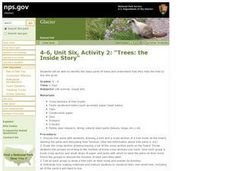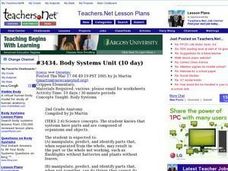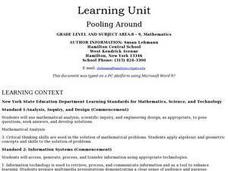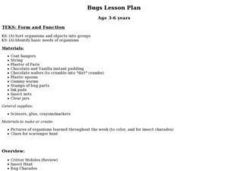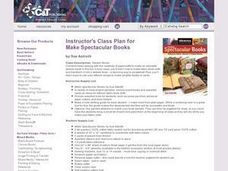Curated OER
Pascal's Triangle
Students study Pascal's triangle. They construct their own version of Pascal's triangle, and relate some of the uses for it. While working through this process, students practice their integer multiplication and division skills.
Curated OER
Contour Wrapped Animal Portrait
Students will select a high interest animal portrait. After completing an n accurate light line drawing, the portrait will be finished using contours lines constructed of implied wrapping using pencil and pen. The eyes will be completed...
Curated OER
Puzzle Prints
Pupils explore the basic techniques of printmaking in this introductory lesson for the elementary Art classroom. Included with this lesson are ideas for successful implementation and step-by-step directions for the teacher with no...
Curated OER
Sample Activity From The Water Sourcebook
Students explore septic system failures and contamination of groundwater. The complete a worksheet to explore the basic parts of a septic system. In a lab situation, students simulate a septic system failure. They explore coliform...
Curated OER
Where's the CAT? a DNA Profiling Simulation.
Students explore DNA technology. Students participate in a simulation to perform at the basic steps of a DNA profile. They observe copies of DNA sequences, construct DNA probes, and discuss outcomes of their experiment.
Curated OER
Weather
Second graders study the basic components of weather. They construct a thermometer and anemometer to measure temperatures, precipitation, and wind speed. In addition, 2nd graders discover how to find these components on weather maps.
Curated OER
Operations with Decimal Numbers
Sixth graders demonstrate operations with decimal numbers. In this computation lesson, 6th graders play the game "Diabolical Decimals." The objects of this game is to construct the largest number after rolling a die five times. The...
Curated OER
Pedestrian Safety for Students
Learners demonstrate pedestrian safety. In this safety lesson, students present an idea for a project which addresses pedestrian safety. Learners can construct a safety brochure or a PowerPoint presentation to share their ideas.
Curated OER
What it means to be a scientist and What is the Scientific Process?
Students read an article and describe the scientific method. In this scientific process lesson, students compare basic science and applied science. Students discuss ideas such as team work, application of an idea, how scientists...
Curated OER
Making a Magical Story
Students create their own magical story. In this story writing lesson, students listen to the story The Lion, The Witch, and the Wardrobe b C.S. Lewis to find the basic elements of a story. They come up with their own magical...
Curated OER
Trees: The Inside Story
Students explore trees. In this math lesson, students identify the basic parts of trees. Students create a model of a tree and label the parts.
Curated OER
Model Rockets
Students study the basics of a model rocket and its classifications. In this rocket instructional activity students determine the flight duration of a model rocket.
Curated OER
Life Beyond the Fifty Yard Line -- An ecological look at our backyard
Learners, in groups, stake out and rope off their study area, do population counts and density studies. They construct a map of the whole area, collect plants and insects, and mount and identify the organisms using keys.
University of Arizona
The Leg Bone Is Connected to The...
Learners discover the names of 13 major bones in the human skeletal system. They construct their skeleton using paper plates and other simple products. Links to templates are provided within the resource.
Curated OER
A More Perfect Product
Students participate in a discussion about the basics of house design including the influence of site, materials, function, form and style. They explore these concepts by creating a floor plan and conceptual drawing of a house.
Curated OER
Cell Structures and Functions
Fifth graders search into animal and cell characteristics and their functions in this seven lesson plan unit. Replicas of the cell are constructed out of Jell-O as students probe the internet for details of the concepts.
Curated OER
Body Systems Unit
Second graders complete a unit of lessons on the body systems. They watch the video, Magic Schoolbus Inside the Human Body, trace their bodies and construct the systems on the tracing, simulate the digestive system, and participate in...
Curated OER
Pooling Around
Learners complete a unit of lessons on computing area and volume. They play a Jeopardy game of basic area formulas, calculate surface area of shapes, develop a Powerpoint presentation, and conduct a simulation of finding the surface area...
Curated OER
Bugs Lesson Plan
Students complete a unit of lessons on insects. They participate in a bug hunt, construct paper flowers, discuss pollination, create bug paperweights and insect mobiles, play bug charades, and participate in a bug scavenger hunt.
Curated OER
The Synthesis of Some Organic Compounds And Their Representative Structures
Young scholars examine how to represent organic compounds three-dimensionally. They write a synthesis reaction for three demonstrations, and construct a three-dimensional structure using a molecular modeling set.
Curated OER
Wire Maze
Students investigate what causes electrical circuits to work. They construct a wire circuit and pass a paperclip through the maze, trying not to touch the wire, and answer discussion questions.
Curated OER
Make Spectacular Books
Students view a demonstration on how to make a skewer book. Using various types of fabric, they transform it into a skewer book to be used for scrapbooking. They share their books with the class and ask for constructive criticism.
Curated OER
Warm/Cool Leaves
Learners examine the difference between warm and cool colors. They discuss the basic color wheel, reviewing primary, secondary and complimentary colors. An activity allows students to discover how to mix the warm and cool colors.
Curated OER
ART- LANGUAGE OF SYMBOLS
Learners discuss how color construct meaning in art. They will demonstrate a technical knowledge and creative use of formal elements and principals of design. Students then discuss the way their selection of color contributed to their work.










